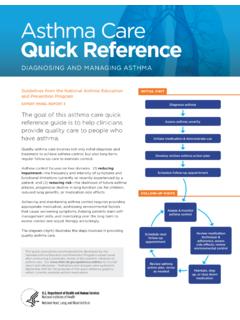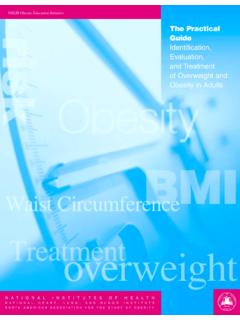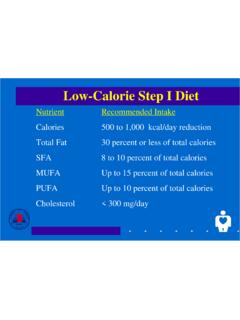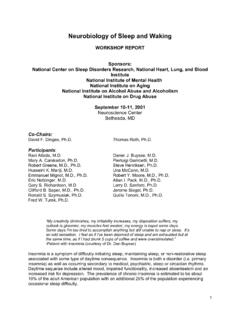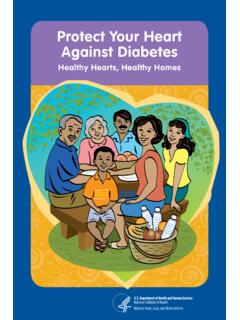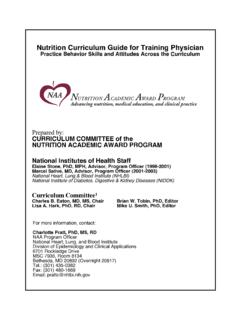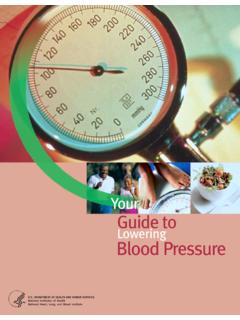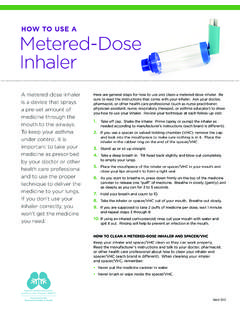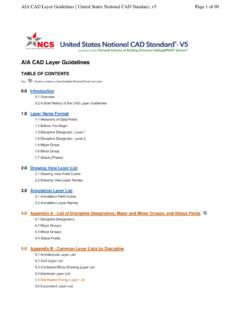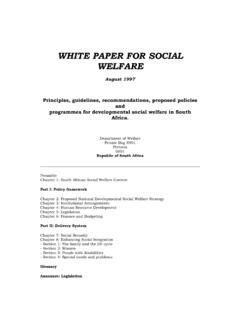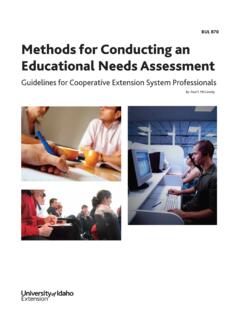Transcription of SECTION 5, MANAGING EXACERBATIONS OF ASTHMA
1 SECTION 5, MANAGING EXACERBATIONS of ASTHMA 373 August 28, 2007 SECTION 5, MANAGING EXACERBATIONS OF ASTHMA KEY POINTS: MANAGING EXACERBATIONS OF ASTHMA Early treatment of ASTHMA EXACERBATIONS is the best strategy for management. Important elements of early treatment at the patient s home include (EPR 2 1997 ): Patient education, including a written ASTHMA action plan to guide patient self-management of EXACERBATIONS at home, especially for patients who have moderate or severe persistent ASTHMA and any patient who has a history of severe EXACERBATIONS (Evidence B). A peak-flow-based plan may be particularly useful for patients who have difficulty perceiving airflow obstruction and worsening ASTHMA (Evidence D). Recognition of early signs of worsening ASTHMA and taking prompt action (Evidence A). Appropriate intensification of therapy by increasing inhaled short-acting beta2-agonist (SABA) and, in some cases, adding a short course of oral systemic corticosteroids (Evidence A).
2 Removal or withdrawal of the environmental factor contributing to the exacerbation. Prompt communication between patient and clinician about any serious deterioration in symptoms or peak flow, decreased responsiveness to SABAs, or decreased duration of effect. Management of ASTHMA EXACERBATIONS requiring urgent medical care ( , in the urgent care setting or emergency department (ED)) includes: Oxygen to relieve hypoxemia in moderate or severe EXACERBATIONS (EPR 2 1997 ). SABA to relieve airflow obstruction, with addition of inhaled ipratropium bromide in severe EXACERBATIONS (Evidence A). Systemic corticosteroids to decrease airway inflammation in moderate or severe EXACERBATIONS or for patients who fail to respond promptly and completely to a SABA (Evidence A). Consideration of adjunct treatments, such as intravenous magnesium sulfate or heliox, in severe EXACERBATIONS unresponsive to the initial treatments listed above (Evidence B). Monitoring response to therapy with serial measurements of lung function (Evidence B).
3 Preventing relapse of the exacerbation or recurrence of another exacerbation by providing: referral to followup ASTHMA care within 1 4 weeks; an ED ASTHMA discharge plan with instructions for medications prescribed at discharge and for increasing medications or seeking medical care if ASTHMA worsens; review of inhaler techniques whenever possible; and consideration of initiating inhaled corticosteroids (ICSs) (Evidence B). SECTION 5, MANAGING EXACERBATIONS of ASTHMA 374 August 28, 2007 KEY DIFFERENCES FROM 1997 AND 2002 EXPERT PANEL REPORTS For the assessment of EXACERBATIONS , the current update (EPR 3: Full Report 2007): Simplifies classification of severity of ASTHMA EXACERBATIONS . Reinstates, for use in the urgent or emergency care setting, the 1991 cut points of forced expiratory volume in 1 second (FEV1) or peak expiratory flow (PEF) to indicate the goal for discharge from the urgent care or emergency care setting ( 70 percent predicted FEV1 or PEF); patients for whom response to therapy is incomplete and who usually require continued treatment in the ED (40 69 percent predicted); and the exacerbation severity level where adjunct therapies may be considered (<40 percent predicted).
4 These cut points differ from those used to determine long-term ASTHMA control and treatments, thus underscoring the distinction between acute and chronic ASTHMA management. Acknowledges the limited value of pulmonary function measures in very severe EXACERBATIONS . For the treatment of EXACERBATIONS , the current update: Adds levalbuterol as a SABA treatment for ASTHMA EXACERBATIONS . For home management of EXACERBATIONS , no longer recommends doubling the dose of ICSs. For prehospital management ( , emergency transport), encourages standing orders for albuterol and for prolonged transport repeated treatments and protocols to allow consideration of ipratropium and oral corticosteroids. For ED management, reduces dose and frequency of administration of oral corticosteroids in severe EXACERBATIONS , adds consideration of magnesium sulfate or heliox for severe EXACERBATIONS , and adds consideration of initiating an ICS upon discharge. For hospital management, no longer recommends ipratropium bromide.
5 Introduction In this SECTION , recommendations are presented for the assessment and treatment of EXACERBATIONS in the home, ED, and hospital. See SECTION 1, Overall Methods Used To Develop This Report, for literature search strategy and tally of results for this EPR 3: Full Report 2007 SECTION on MANAGING EXACERBATIONS of ASTHMA . Four Evidence Tables were prepared: 17, Increasing the Dose of Inhaled Corticosteroids; 18, IV Aminophylline; 19, Magnesium Sulfate; and 20, Heliox. ASTHMA EXACERBATIONS are acute or subacute episodes of progressively worsening shortness of breath, cough, wheezing, and chest tightness or some combination of these symptoms. SECTION 5, MANAGING EXACERBATIONS of ASTHMA 375 August 28, 2007 EXACERBATIONS are characterized by decreases in expiratory airflow that can be documented and quantified by simple measurement of lung function (spirometry or PEF). These objective measures more reliably indicate the severity of an exacerbation than does the severity of symptoms.
6 In general, milder EXACERBATIONS may be managed at home ( , outside the health care system), whereas more serious EXACERBATIONS may require an unscheduled ( urgent ) office visit, an ED visit, or a hospital admission (see figure 5 1). The most severe EXACERBATIONS require admission to the intensive care unit (ICU) for optimal monitoring and treatment. Although assessment and treatment of young children pose unique challenges, the management of ASTHMA EXACERBATIONS in older children and adults is fairly similar. Individuals who have their ASTHMA under control with ICSs will decrease the risk of EXACERBATIONS . Nonetheless, patients in good control can still be vulnerable to EXACERBATIONS , for example, when they have clinical respiratory infections (Reddel et al. 1999). Diurnal variability, a marker of poor control, may not change during an exacerbation; thus, clinicians may fail to detect important changes in lung function. The striking difference between PEF FIGURE 5 1.
7 CLASSIFYING SEVERITY OF ASTHMA EXACERBATIONS IN THE URGENT OR EMERGENCY CARE SETTING Note: Patients are instructed to use quick-relief medications if symptoms occur or if PEF drops below 80 percent predicted or personal best. If PEF is 50 79 percent, the patient should monitor response to quick-relief medication carefully and consider contacting a clinician. If PEF is below 50 percent, immediate medical care is usually required. In the urgent or emergency care setting, the following parameters describe the severity and likely clinical course of an exacerbation. Symptoms and Signs Initial PEF (or FEV1) Clinical Course Mild Dyspnea only with activity (assess tachypnea in young children) PEF 70 percent predicted or personal best Usually cared for at home Prompt relief with inhaled SABA Possible short course of oral systemic corticosteroids Moderate Dyspnea interferes with or limits usual activity PEF 40 69 percent predicted or personal best Usually requires office or ED visit Relief from frequent inhaled SABA Oral systemic corticosteroids; some symptoms last for 1 2 days after treatment is begun Severe Dyspnea at rest; interferes with conversation PEF <40 percent predicted or personal best Usually requires ED visit and likely hospitalization Partial relief from frequent inhaled SABA Oral systemic corticosteroids.
8 Some symptoms last for >3 days after treatment is begun Adjunctive therapies are helpful Subset: Life threatening Too dyspneic to speak; perspiring PEF <25 percent predicted or personal best Requires ED/hospitalization; possible ICU Minimal or no relief from frequent inhaled SABA Intravenous corticosteroids Adjunctive therapies are helpful Key: ED, emergency department; FEV1, forced expiratory volume in 1 second; ICU, intensive care unit; PEF, peak expiratory flow; SABA, short-acting beta2-agonist SECTION 5, MANAGING EXACERBATIONS of ASTHMA 376 August 28, 2007 variations during EXACERBATIONS , as compared with during poor ASTHMA control, suggests differences in beta2-adrenoceptor function between these conditions. The decrease in responsiveness to SABA during some severe EXACERBATIONS may help to explain the benefit of ipratropium bromide and other alternative approaches to bronchodilation. General Considerations Based on the scientific literature and the opinion of the Expert Panel, the Panel recommends that clinicians consider the following general principles and goals for MANAGING ASTHMA EXACERBATIONS : early treatment, special attention to patients who are at high risk of ASTHMA -related death, and special attention to infants (EPR 2 1997 ).
9 Early treatment is the best strategy for management of ASTHMA EXACERBATIONS . Important elements of early treatment include: A written ASTHMA action plan (See Component 2: Education for a Partnership in ASTHMA Care, figure 3 10) to guide patient self-management, especially for patients who have moderate or severe persistent ASTHMA and any patient who has a history of severe EXACERBATIONS . Recognition of early indicators of an exacerbation, including worsening PEF. Patients are instructed to recognize early signs and symptoms of worsening ASTHMA and to use quick-relief medications if symptoms occur or if PEF drops below 80 percent predicted or personal best. If PEF is 50 79 percent, the patient should carefully monitor the response to quick-relief medication and, based on the response, consider contacting a clinician. If PEF is below 50 percent, immediate medical care is usually required (See sample written ASTHMA action plans, figures 3 10a, b, and c.). In the urgent or emergency care setting, different parameters are used to classify the severity of the exacerbation and determine the clinical course; see figure 5 1.
10 The Panel chose cut points of 40 percent and 70 percent of predicted (or personal best) because 40 percent denotes an exacerbation severity below which several adjunct therapies are effective, and 70 percent is a posttreatment goal for discharge from the ED or hospital. Appropriate intensification of therapy, often including a short course of systemic corticosteroids. Removal of or withdrawal from allergens or precipitating irritants in the environment that may be contributing to the exacerbation. Prompt communication between patient and clinician about any serious deterioration in symptoms or peak flow, decreased responsiveness to SABA treatment, or decreased duration of effect. Patients who are at high risk for ASTHMA -related death require special attention particularly intensive education, monitoring, and care. Such patients should be counseled to seek medical care early during an exacerbation and instructed about the availability of ambulance services. Such patients include those who have identifiable risk factors (See figure 5 2a.)

